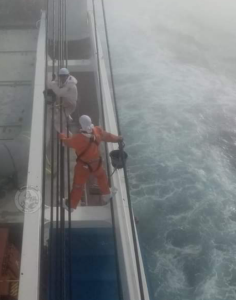The Charity
Aviation
Maritime
M1987

Initial Report
Our reporter sent us this picture of two seafarers working on a crane at height while the vessel was underway at sea in poor weather conditions. They appear to be re-greasing the sloping wires of a crane. Their lifelines are attached to the same wires. Nothing would stop them from falling to the bottom if they slipped and fell.
They are not wearing safety helmets or lifejackets despite being close to the edge of the vessel. This activity took place in full view of the bridge team, but they were neither challenged nor stopped.
CHIRP Comment
Good equipment design can eliminate operating and maintenance hazards. In this case, it could have been possible to design the crane to be lowered to the deck to allow maintenance to take place without ever sending someone aloft. If that were not possible, the designer could have added hand-holds and connection points for safety harnesses to be attached so that the crew had safe access.
When accepted into service by the Flag State and Classification Society, did either organisation audit the maintenance routines to ensure they were safe? It is unlikely that either body would agree that sending people aloft by balancing on greasy wires is a safe system of work.
Is this then a poor local practice? If so, it is sadly a common practice that occurs on many ships. CHIRP questions why the wire cannot be run out onto the deck and grease added as the wire is rewound in?
The maintainers are wearing loose plastic overshoes – this is a common (but unsafe) way of keeping your footwear clean and avoiding transferring the grease from the wires onto the deck. However, grease and loose overshoes significantly increase the likelihood of slipping and falling, and you should carefully consider the risks if you use them.
The crew member in white overalls appears to be wearing only a harness around the waist, not a full-body harness. An incorrect or badly fitted harness increases the risk of internal injuries when coming to a sudden stop at the end of the lanyard.
Fall arrestors reduce this shock but need you to fall another 2-4m to work correctly. If there is insufficient clearance to fall this distance without hitting an object or the deck, the wearer could hit these objects at full speed and be seriously injured. In the photograph, the crew members would likely fall onto the crane arms before their safety harnesses could work.
Hanging motionless in a harness restricts blood circulation and can cause breathing difficulties (this is often called ‘suspension trauma’) if you are not rescued within 15 minutes. If you are sent aloft wearing a harness, make sure there is a rescue plan in place. A rescue plan is a pre-planned procedure to safely retrieve someone suspended at height in a harness. It should also be regularly practised to ensure it can be done safely and quickly.
If your ship uses safety harnesses for working aloft, make sure there is a rescue plan in place.
CHIRP questions why this task could not have been delayed until the weather had improved and wonders if this is an indicator that the ship’s programme was too full to allow maintenance to be properly and safely completed.
Key Issues relating to this report
Alerting– Our reporter may have sent this to us because they did not feel able to alert the master or OOW. If you saw this happen on board your vessel, would you be listened to, or is this usual practice? Tell us about your experiences.
Teamwork- Why didn’t the bridge team intervene? They are all part of the same team.
Supervision/Local practices- Did this incident occur because supervision was lacking, or was it an acceptable local practice to balance on the wires?
Capability- Are the individuals correctly trained to wear a safety harness? Does the ship have a rescue plan? Are you sent aloft in a harness when no rescue plan exists? What happens on your vessel?
Pressure- Was inappropriate time pressure put on the officers and crew to take risks to keep the vessel running to a timetable? Is profit put above safety? If so, why? This task is probably not time-critical and could have been delayed until the weather conditions were more appropriate.
This data type is not supported! Please contact the author for help.






